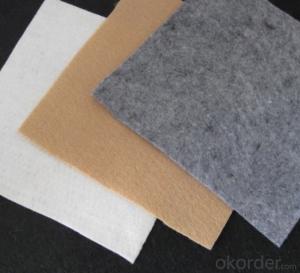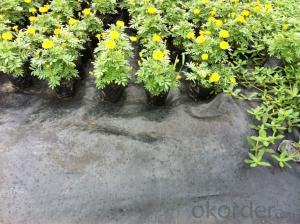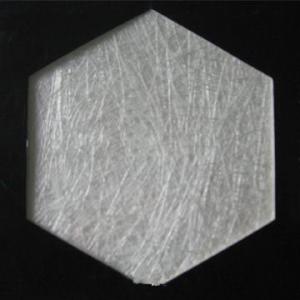Maya Geotextil PP Geotextile for Construction/Landscape Fabric/Weed Barrier
- Loading Port:
- China main port
- Payment Terms:
- TT OR LC
- Min Order Qty:
- 5000 m²
- Supply Capability:
- 1000000 m²/month
OKorder Service Pledge
OKorder Financial Service
You Might Also Like
Weed Barrier Fabric Introduction
Weed Barrier Fabric are composed from synthetic polypropylene/polyester fibres through a mechanical process of needling the fabric and adding, when necessary, a thermo fused process, resulting in a uniform porous structure with excellent tensile strength and chemical deterioration.
Type: 1. Wovens & knitted: use various fibre types in different combinations.
2. Non-wovens: staple or continuous fibres that are heat treated or needlepunched to “fix” fibres relative to each other.


Weed Barrier Fabric Specification
1) Weight / Mass: 75g/m2-400g/m2 .
2) Width: Within 8 m (1m-8m)
3) Length: 50m-100m/roll (as request)
4) Material: PP
5) Color: Black , white , grey, others
6) The biggest geotextile manufacturer/factory in China for many years . The equipment is introduced from Germany.
7) This geotextile can be made of polypropylene (PP).
8) The mass is available from 75g/m2 to 400g/m2 and the width available from 1.0m-8m, monolayer or multilayer (reinforcement geotextiles), long fiber or short fiber.
9) Color: all kinds of color are available. The annual production ability is 10 million square meters.
10) The fabric can also be heat treated by infrared at customer's requirements. Our geotextile are UV stabilized to give protection against aging under exposure to natural ultra-violet light.


Weed Barrier Fabric Application
1) Filtration
The filtration layer of the dykes, river canal, seacoast, concrete slope, retaining walls. At the same time of preventing the clay granule from passing, it allows the water and the gas pass through freely.
2) Separation:
The isolation of the railway dregs and the roadbed, roadbed and the soft base, surface of the airdrome and parking lot and the groundsill, different dam materials. It isolates the soil and the gravel of two kinds different granule pathway from the groundsill or other buildings.
3 )Reinforcement:
The highway, railway, soil-stone dam, breakwater, airport, backfill soil of retaining wall, slope protection, etc in which distributes the earth stress, prevents the side-displacement of the earth body and improves the earth body stability.
4 )Protection
It prevents the bank from being washed out, protects the bank and the bottom, prevents the water and soil from being washed away.
FAQ:
Q1: What is your minimum order quantity?
A:The minimum order quantity is 5000 ,but it is negotiable.
Q2:What is your payment terms?
A: T/T,Western Union,Paypal,L/C...
Q3:What is your delivery time?
A:Production time usually costs 2-20 days.
Waiting to cooperate with you!
- Q: What are the standards and regulations for geotextile products?
- The standards and regulations for geotextile products vary depending on the country and region. However, some common standards and regulations include ASTM D4439 for geotextile testing, ASTM D5261 for geotextile installation guidelines, and ISO 10318 for geotextile specifications. Additionally, in many countries, geotextile products must meet specific requirements set by government agencies or industry organizations to ensure their quality, durability, and environmental impact.
- Q: Geotextile in the asphalt layer under what role
- Geotextile play the role of reinforcement, protection.
- Q: What are the durability considerations for geotextiles?
- Durability considerations for geotextiles include factors such as tensile strength, resistance to ultraviolet (UV) degradation, chemical resistance, and abrasion resistance. Geotextiles should have sufficient tensile strength to withstand the stresses and strains imposed on them during installation and the lifespan of the project. UV degradation can weaken geotextiles over time, so it is important to choose products with appropriate UV resistance. Chemical resistance ensures that geotextiles remain intact and functional in the presence of chemicals or contaminants in the soil or water. Additionally, geotextiles should be resistant to abrasion to withstand any potential friction or rubbing against other materials or objects.
- Q: Can geotextiles be used in landfill lining systems?
- Yes, geotextiles can be used in landfill lining systems. They are commonly employed as a part of the composite liner system in landfills to enhance the performance and longevity of the landfill liner. Geotextiles help in preventing the migration of contaminants, provide stability, and increase the overall efficiency of the landfill lining system.
- Q: How do geotextiles help with reinforcement of steep slopes?
- Geotextiles are used in the reinforcement of steep slopes by providing stability and preventing soil erosion. They act as a barrier between the soil layers, distributing the weight and stress evenly across the slope. This helps to increase the shear strength of the soil, reducing the likelihood of slope failure. Additionally, geotextiles allow water to drain through them, reducing the buildup of excess moisture and providing better drainage, which further helps in preventing erosion and maintaining the stability of the slope.
- Q: How do geotextiles aid in the reduction of soil settlement?
- Geotextiles aid in the reduction of soil settlement by providing a stable and reinforced layer that helps distribute loads and prevent the soil particles from settling. It acts as a barrier, allowing water to pass through while preventing fine soil particles from being washed away, thus maintaining the integrity of the soil.
- Q: How do geotextiles help with reinforcement of geogrids?
- Geotextiles help with reinforcement of geogrids by acting as a separation layer between the geogrid and the surrounding soil or aggregate. This separation prevents the intrusion of fine particles into the geogrid, which could reduce its effectiveness in providing reinforcement. Additionally, geotextiles provide additional tensile strength and distribute loads more evenly across the geogrid, enhancing its overall performance and durability.
- Q: What is the difference between woven and non-woven geotextiles?
- Woven geotextiles are made by interlacing yarns or fibers together, creating a strong and durable fabric. They have a high tensile strength and are commonly used for applications that require high load-bearing capacity, such as stabilizing soil or preventing erosion. Non-woven geotextiles, on the other hand, are made by bonding fibers together using heat, chemicals, or mechanical processes. They are generally less strong and more flexible than woven geotextiles. Non-woven geotextiles are often used for filtration, separation, or drainage purposes, where their permeability and ability to retain fine particles are important factors.
- Q: Engineering geotextile non-woven fabrics where the cheapest can buy, where the wholesale market?
- Manufacturers need to add 8720 -
- Q: Are geotextiles suitable for use in high-traffic areas?
- Yes, geotextiles are suitable for use in high-traffic areas. Geotextiles are engineered materials that offer high strength, durability, and resistance to wear and tear. They can effectively distribute loads, prevent erosion, and stabilize the ground, making them a suitable choice for high-traffic areas such as roads, parking lots, and construction sites.
Send your message to us
Maya Geotextil PP Geotextile for Construction/Landscape Fabric/Weed Barrier
- Loading Port:
- China main port
- Payment Terms:
- TT OR LC
- Min Order Qty:
- 5000 m²
- Supply Capability:
- 1000000 m²/month
OKorder Service Pledge
OKorder Financial Service
Similar products
Hot products
Hot Searches
Related keywords


































